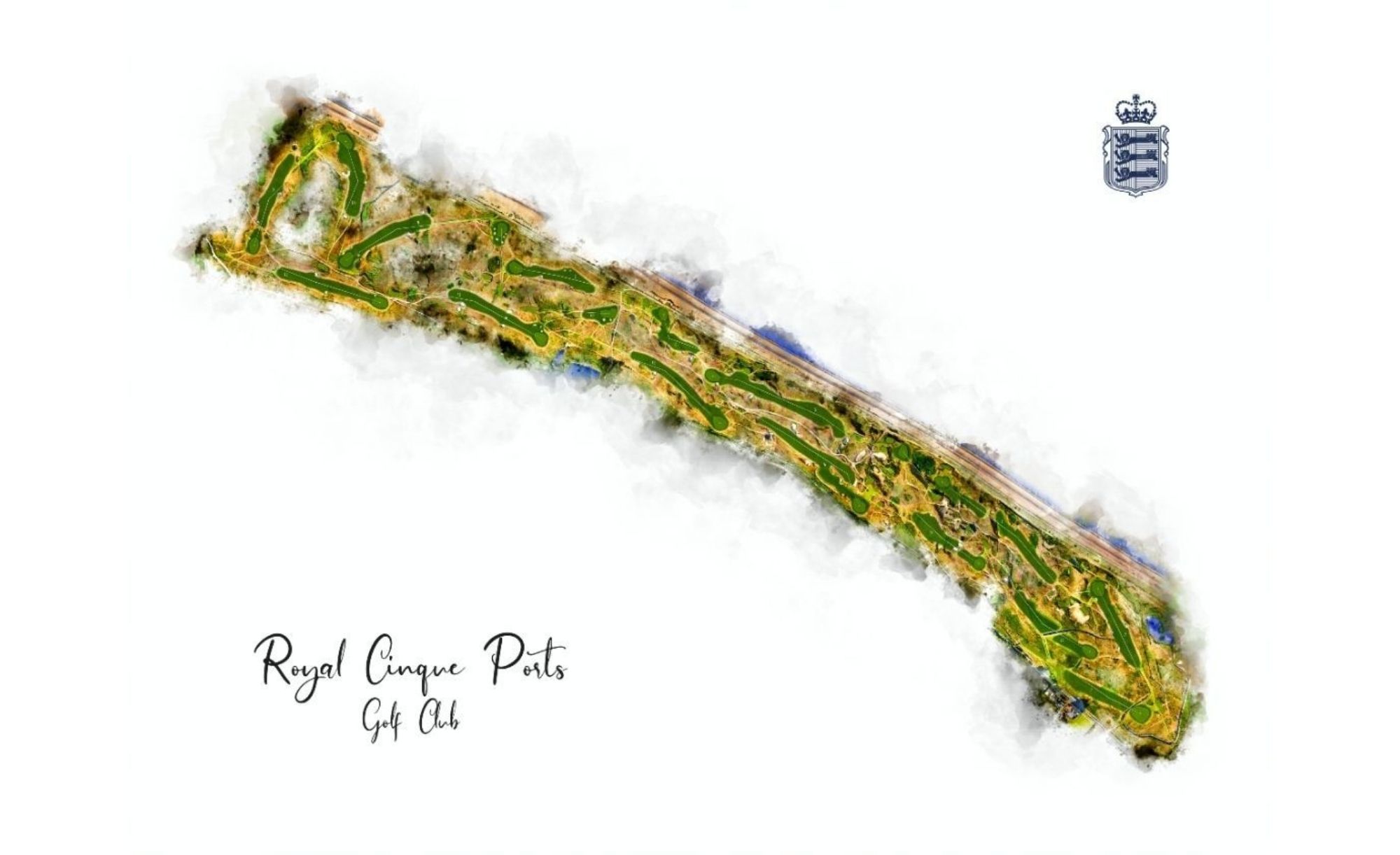Royal Cinque Ports Golf Club

Overview
- This is HIIG = High-Intensity Interval Golf. You ease into the round. 2 through 6 is like running a gauntlet. 7 through 11 offers a small reprieve before another rambunctious stretch of holes from 12 through 17. 18 looks modest by can sting if not respected.
- RCP is deceptive. What you think is coming based on the view from the road is almost the exact opposite.
- Despite an out and back routing, the holes vary greatly in orientation.
- The revetments are thick! Dornoch-esque in nature.
- The green sites, especially 3 and 16, are some of the best green complexes in the British Isles, if not the world.
- The green sites often are linked directly to the next teeing ground. A little detail that really makes a difference somehow. It seems as though the flow of the round continually perpetuates.
- RCP is truly unique. Round 'flow' and the cerebral aspect of golf course design is clearly evident and palpable. Much of this is due to the sea wall.
- The strategic value of holes 6 & 16 is off the charts.
- James Braid's original work is seen on holes 8, 10 and 11. He modified holes 13, 14 and 15.
- Rare is the quality of the practice facilities. A full length, grass tee driving range is on offer as is an ample short game area.
- Deal is also home to the world's largest, true-amateur golf tournament, held over 4 days in April, with 64 public schools tendering teams.
- Andrew Reynolds is the club's pro and a real raconteur. Visit the shop and you'll be repaid with some amusing tales!
Golf Course Review
Royal Cinque Ports Golf Club, or Deal, is a member's, world-class, championship two-ball club.
Its name is derived from a confederation of maritime towns and villages in Kent and East Sussex dating back 1000 years. Before the English navy was established, the men and ships of these five ports provided military support and transportation on behalf of the Tudor crown. It is very much the cradle of the Royal Navy. Deal is a limb of the head port of Sandwich.
Before we delve in, let's briefly look at Royal Cinque Ports Golf Club's history and its association with the Open Championship.
Royal Cinque Ports Golf Club History
Royal Cinque Ports Golf Club was founded in February of 1892. By the end of May, the first nine holes were opened by Harry and Ramsay Hunter. Ramsay was the Keeper at Sandwich and Harry became the Keeper at Deal. Elements of the original nine still exist today. Holes 1, 2, and 3 would have made up a considerable part of the opening holes with holes 16, 17 and 18 making up much of the closing three holes of the original nine.
In 1898, Harry Hunter extended it to 18 holes but it was mostly lost due to WW1. James Braid was called upon to reorganise the layout after the Great War in 1919. His work included new holes on 8, 10, and 11. He also modified holes 13, 14, and 15.
In 1919, Royal Cinque Ports Golf Club underwent further improvement in preparation for the Open that would end up being won by George Duncan. Holes 8 through 13 were changed by altering the routing to tack to and fro rather than out and back. It was agreed that no alterations were needed for the last four holes.
In preparation for the 1938 Open, John Morrison was called in to alter Royal Cinque Ports Golf Club. His biggest alteration was the removal of the famous 4th hole known as Sandy Parlour. It was all for not as the course flooded and the Open hosted by Sandwich.
The course was again affected by WW2. It was reported that 12 greens remained, 4 were lost and the others were damaged by as much as 80%. Sir Guy Campbell and Henry Cotton restored the Hunter Brothers and James Braid layout and play recommenced in 1946.
Royal Cinque Ports Golf Club has found its location to be both a blessing and a curse due to flooding. Storms and high tides have devasted the links in 1897, 1953, and 1978. In 1979, the timber seawall was replaced with the current defense of concrete and shingle. The club still owns the property up to the high tide line which allows it to place teeing grounds on the wall and keep the beach in play.
Royal Cinque Ports Golf Club & The Open
In 1907, Royal Cinque Ports Golf Club was awarded the 49th Open in 1909 won by JH Taylor. Following that, it was meant to host the 55th Open in 1915 but, due to the Great War, it never came to fruition. It again hosted The 55th Open in 1920 won by George Duncan, thus making it the planned venue for the Championship three times in 12 years from 1909 to 1920.
Royal Cinque Ports Golf Club was again meant to host the Open in 1938 and 1949 but due to high tides on both occasions, the tournament was moved to Royal St. George's. What makes this interesting is that if all had gone to plan, by 1949, Deal would have hosted five Opens and Sandwich, seven. Instead, by 1949 Sandwich had hosted nine Opens and Deal, two. Had Deal hosted two, fine tournaments in 1938 and 1949, would the R&A have looked differently upon Royal Cinque Ports Golf Club as an Open venue since 1950?
Deal's Highlights
Hole 1
A relatively straightforward opening hole. With easy parallels drawn to the opening hole at the Old Course, it's all there in front of you with a burn running in front of the green. The road, clubhouse and pro-shop are O.B. but it doesn't mean they aren't in play. A wide, gently undulating fairway and the largest green on the course gives you a warm introduction. The green is beautifully contoured and would likely be the most undulating on many other courses... Now buckle up as it gets a lot more interesting from here on out. Many tied matches are broken on the first with the member's making up the gallery from the clubhouses' first-floor veranda.
Hole 2
The fairway bunkers are perfectly situated to catch any drive that is less than carefully placed if you're playing from the appropriate tees. Similar to the Kitchen on the first at Royal St Georges, the left-hand side of the fairway will gather most tee shots. An approach from the right-hand side of the fairway and further back may provide a better view of your target which is a plateau/punchbowl. Your introduction to Royal Cinque Ports Golf Club and its undulations is well and truly underway from the second fairway onwards. This is a just taste of what's to come!
Hole 3
A relatively short par 5 that makes use of natural features to maximum effect. A pure drive from tees sat amongst newly, reintroduced sand scrapes, may allow you to go for the green in two. Despite being short, the play may well be as a true, three-shot par 5. A tee shot to somewhat level ground short of the right-hand side, fairway pot bunker. A second shot left of the spectacles just over the dune ridge before a final third to the punchbowl green.
This is cerebral golf at its best. A dual fairway, short 3-shot hole that will make you think and question the soundness of your decisions on every shot. The first time you play the third may well be the best reveal in golf. The green is a punchbowl of epic proportions, the scale, and severity unlike any I have ever seen. The walk from the spectacles to the green complex is one you will never tire of.
Hole 4
A par 3 that proves you don't need bunkers to make a one-shot hole great. Due to the green's orientation, the left tees will test the correct line of approach and the right tee more the skill of distance control. Every shot from the approach on the second until the final putt on this green requires resolute concentration. The first sea-view afforded from the elevated tee imperceptibly causes you to lose your focus just before the round's shortest but most demanding tee shots. Like many holes at Royal Cinque Ports Golf Club, the test here is not just one of skill but also of mental agility.
Hole 5
The second par 5 in three holes, it appears more straightforward than the previous. However, there is so much movement in the fairway you can hit two perfect shots and still have a blind third into the green. The green is false fronted and multi-tiered as well as running off on all sides. Two or three well-executed shots may well not yield a green in regulation. The biggest test here may not be the required shots but rather your attitude to the inherent unfairness of the game. The fifth will test your resolve in this respect.
Hole 6
A strategic gem. The tees lie alongside the sea wall. The low handicap player has three valid options:
- Choose a direct line to the green. Successfully played it can end with an eagle, likely a birdie and at worst a par.
- A tee shot to the level plateau 40 yards long and 25 yards wide leaving you a level lie but a semi-blind approach to an elevated green.
- Drive as close as you can to the generous landing area that could leave you a short pitch from a decent lie to an awkward half shot from a precarious lie.
The risk and reward shot value is immediately calculable. Its simple complexity along with the nature of matchplay make this a hole about which you will question your judgment endlessly... especially if you don't pull it off. If that's not enough, remember the beach is in play... You can read more on Evalu18's deep dive into the 6th hole at Royal Cinque Ports Golf Club.
Hole 7
After the rollercoaster ride that is holes 2 through 6, the tee shot from the back tee on the shingle beach lets you catch your breath whilst affording magnificent, uninterrupted views over the sea. The placid 6th green is in striking contrast to the wildly contoured 7th which runs away from you. The variety of greens in the first seven holes alone is simply incredible.
Hole 8
The first one-shot hole on the course has no bunkers whatsoever, the second makes up for it. A typical James Braid par 3, there are six pot bunkers guarding the front of the green. The relatively new, rear, right teeing ground is genius. It affords sight of the three green-side bunkers guarding the right side. Subconsciously you are inclined to play away from the danger... directly towards the three bunkers opposite.
Hole 10
Perhaps underrated as a strategic hole, 10 again offers options that confound. With 260 yards needed to carry the large blowout bunker on the direct line to the green, many ambitious golfers find themselves playing an awkward approach from it or from the large depression immediately behind it. The green is orientated in such a way that it will gladly accept a shot from the right-hand side of the fairway. To access this spot, however, a tee shot must be carefully played avoiding two perfectly placed bunkers. This is a great example of strategic bunkering on lines of charm.
Hole 12
Similar in feel to the 2nd, the closer you get to the green the wilder it becomes. The inward holes are well and truly underway with this gem. There is no other way but to describe this green as a half-pipe. The green will collect the approach that is run in but avoiding the small bunker guarding the front left which influences play much more than its footprint would lead you to believe.
Hole 13
The second tough par 4 into the prevailing wind. On some links, hazard placement can seem nonsensical with bunkers appearing to be located in the middle of nowhere. The bunkers placed on this hole will provide a test for each category of golfer if they are playing from the appropriate tee, allowing for the drastic changes in both turf and atmospheric conditions.
Hole 14
The only par 3 on the back nine and it makes a statement. At well over 200 yards uphill and into a prevailing wind, this hole can often require a driver. The margin for error is amplified with 3 bunkers on the right side. The bunkers and the mounding surrounding them are nothing short of beautiful. Anything left will leave you upwards of a 35-yard bunker shot to a rear, left pin. For most a driver on a par 3 is a tough pill to swallow. However, during the golden age and hickory age, 200-yard carries were common and the equivalent of this today.
Hole 15
If you doubted that Royal Cinque Ports Golf Club was a Championship test, holes 12 through 15 should convince you. Into the wind from the back tees, the last 3 par 4's average 473 yards! At 476 yards, the 15th doesn't let you take your foot off the gas. Playing back through the same dunes that make up holes 5 & 6, this is a thrill ride from beginning to end. The green again is the highlight tilting from front to back and left to right.
Hole 16
Long hailed as the best hole on the course it has been made better by the re-introduction of the upper, second fairway which ends with a natural blow-out bunker. Previously playing as a long par 4, a new rear tee has added length making this a par 5. With the extra length and an additional shot, this now half-shot hole was turned from a no questions asked, go for it in two proposition into a thinking man's hole with multiple options at every turn. Par fives rarely make you stop and think on all three requisite shots, this is the exception to the rule. On the tee, before any shot is struck, you must plot your strategy from the green back. The green complex is all-world. The only description is it could be likened to a cattleman's cowboy hat crown. If you really want to know what that means, come and see it for yourself. Playing a singles match adds a layer unseen in stroke play. Foursomes would add even more intrigue. The green complex runs perfectly into the teeing ground of 17. These are the little details that keep you locked into the task at hand and show evidence of a greens team that takes pride in their craft.
Hole 17
The run of long holes comes to an end with a brilliant, short par 4. The ideal spot is Vardon's Parlour, a depression on the right-hand side of the fairway which will leave you a short iron into the smallest target on the course. The two bunkers in the middle of the fairway provide visual deception similar to the 3rd at Brancaster, with 50 yards or so of No Man's Land between them and the green.
Hole 18
The burn is in play from an elevated tee in the common fast and firm conditions at Royal Cinque Ports Golf Club. The approach from the right side of the fairway is preferred as a running shot has a better chance of not being rejected from this angle. However, this means flirting with the burn and a longer approach.
Royal Cinque Ports Golf Club Synopsis
Royal Cinque Ports Golf Club may well have the most interesting and compelling green complexes I have ever seen. In addition to numerous green complexes, the 6th and 16th holes are all world candidates. So astounding is the strategy, it is grasped instantaneously.
You may have noticed we didn't highlight Holes 9 or 11. This is not to say these aren't good holes. On the contrary, a set of 18 similar holes would make a course worth playing. Here within lies the genius of Royal Cinque Ports Golf Club. Whether you call it flow or harmony, after a stretch of holes like 2 through 6 and before holes 12 through 17, you absolutely need holes 7 through 11. Their character allows you to absorb the roller coaster ride that you've just been on and allows you ready yourself for what is about to come.
The opening and closing holes at Royal Cinque Ports Golf Club remind me much of the Old Course. Overlooked and perhaps misunderstood, they are all to often compared with standouts 11, 14, and 17. Doing so is a disservice and takes away from their role in the psychology, flow and harmony of the round. The same could be said of 1 and 18 here. They bookend the round and make it cohesive by bringing holes 7 through 11 a part of the fold.
Royal Cinque Ports Golf Club is billed as a member's, world-class, two-ball, championship club. It is exactly this and more... perhaps that is a modest definition of this exceptional course.
Deal's Royal Heritage
Further information on Royal Cinque Ports Golf Club can be found in Scott Macpherson's book, Golf's Royal Clubs.
Deal Course Reviews
Read Golf Club Atlas' review of Royal Cinque Ports Golf Club.
Enjoy Richard Pennell's accomplished write-up of Royal Cinque Ports
Deal Artwork

Royal Cinque Ports Golf Club - Videos
Links From The Road

Featured Architect: MacKenzie, Alister
As taken from his book, Golf Architecture, Alister MacKenzie felt the following were essential: The course, where possible, should be arranged in two loops of nine holes. There should be a large proportion of good two-shot holes and at least four one-shot holes. There should be little walking between...










